Law firms today compete in an intense, high-stakes market. Potential clients are just a click away from choosing another firm, and staying at the top of the organic search results is never guaranteed. But here’s the deal: a well-executed law firm SEO strategy gives your firm the edge to stand out, capture attention, and sign the cases that matter most.
Success online requires strategy, patience, and a bit of grit. Dominating the rankings won’t happen overnight, but there are practical steps you can take today to start seeing results. These aren’t abstract ideas or vague promises. They’re actionable SEO tactics that build a solid foundation for better rankings, more traffic, and, ultimately, the cases you want.
Put these tactics to work, and you’ll see improvement. They won’t make you the market leader overnight, but they’ll lay a solid foundation for sustainable growth—growth that’s measurable, meaningful, and achievable with time and effort.
In short, you’ll learn basic tactics that boost SEO for law firms:
- Strengthen your site’s technical SEO for better performance and visibility.
- Create content that engages your audiences and drives transactional traffic.
- Optimize your pages to rank higher and perform better in search.
- Build foundational backlinks that strengthen your site’s authority.
- Keep your local SEO up to date to attract clients in your community.
- Maintain a solid social media presence to grow your brand’s reach.
Let’s dive in.
Technical SEO Tactics to Build a Strong Foundation
If your website is a house, technical SEO is its foundation. Without it, even the most stunning design and exceptional content can crumble under the weight of poor performance. Technical SEO ensures your website runs smoothly, loads quickly, and delivers a seamless experience for both users and search engines.
Already have a website? Start with these three technical SEO tasks to establish a solid foundation. If you’re building from scratch, partner with a seasoned developer to create a site optimized for search performance, user experience, speed, and conversions.
Know Your Website’s Speed & Health
Speed matters. A sluggish site frustrates potential clients and tells Google your site isn’t worth ranking. The good news? Monitoring site speed and health is easier than you think.
Start with Google PageSpeed Insights. Enter your site’s URL, and you’ll get a detailed report on load time and performance bottlenecks. You’ll see a summary like this:
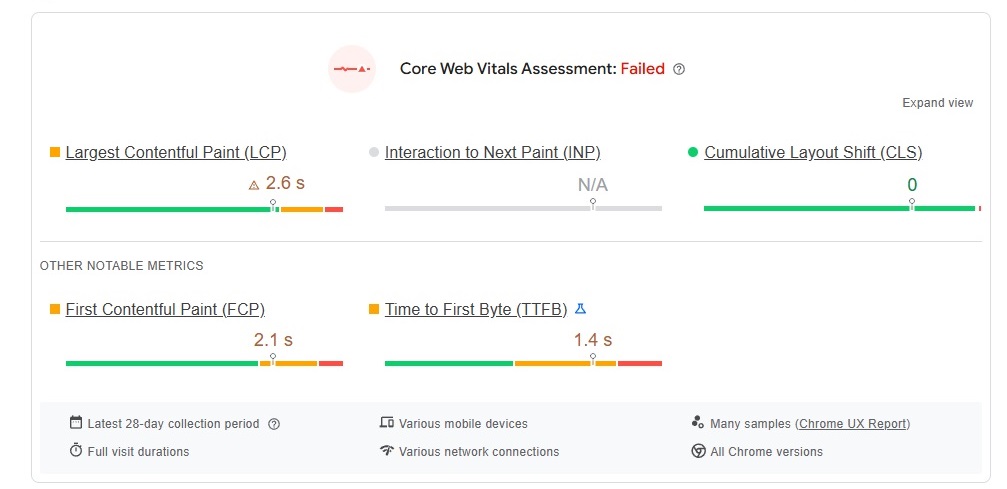
Scroll further and you’ll see details on each category. Here are the Performance metrics for this site:
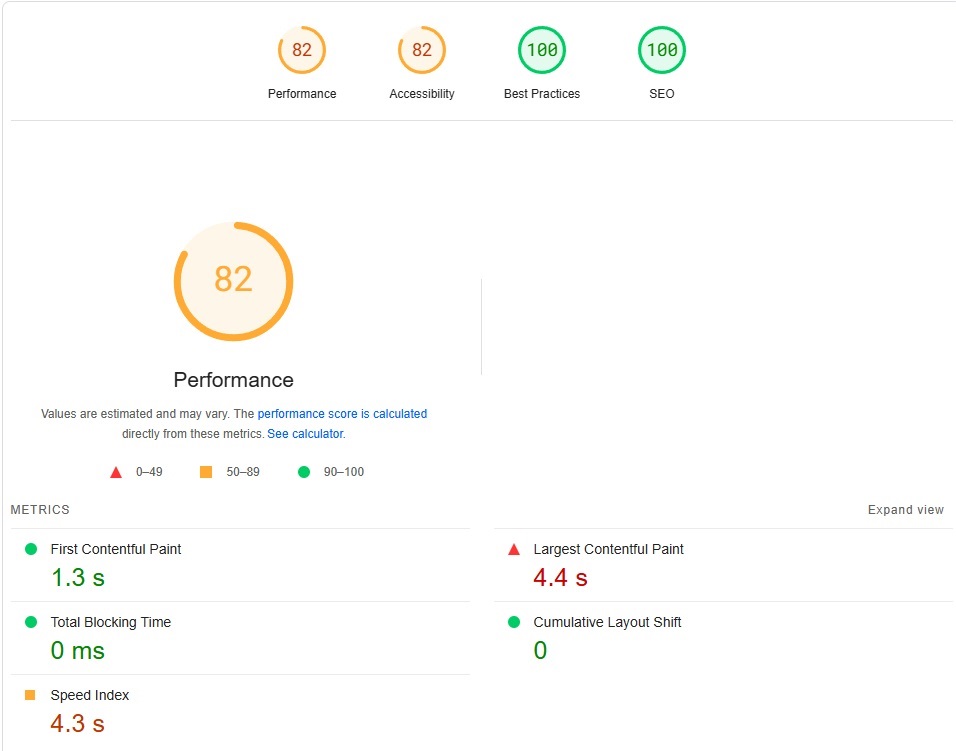
This site is underperforming, especially in terms of speed, and the breakdown highlights exactly where the issues might be. Reports like this offer clear, actionable feedback on what’s slowing your site down—whether it’s unoptimized images, excessive JavaScript, or server issues. If you spot metrics in the red or yellow, bring them to your tech team’s attention.
Next, review your site’s Core Web Vitals in Google Search Console (GSC). Navigate to the Core Web Vitals (CWV) section on the left menu. GSC creates a Mobile and Desktop report. Open both. Here’s an example of a website’s mobile and desktop CWV reports:
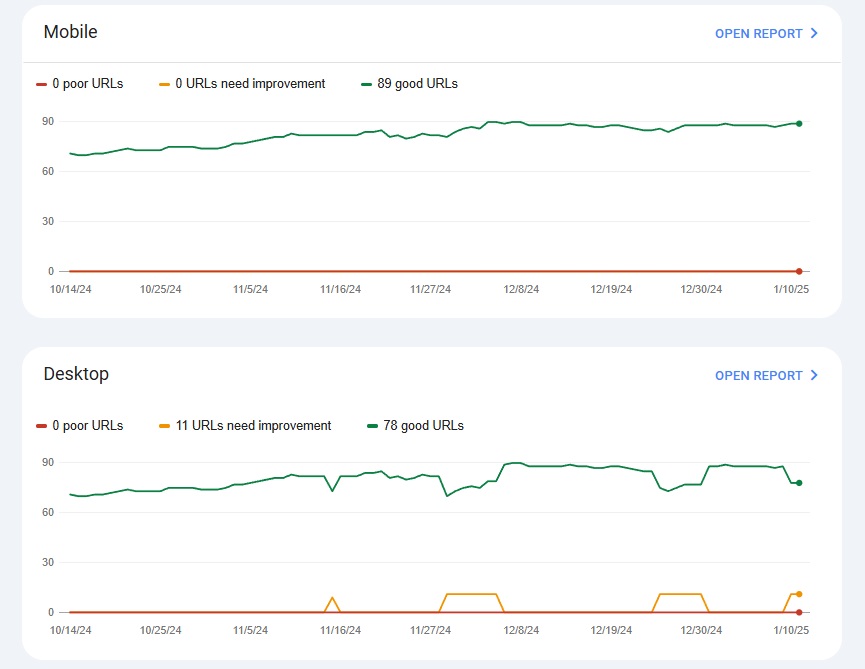
The reports flag critical errors like broken links, crawl errors, or security issues. Any issues labeled Poor requires your technical SEO team’s immediate attention, but it’s also important to have them review issues labeled Needs Improvement as well. Fortunately, nothing is labeled Poor for this site.
Set a weekly routine to check your site’s speed and health. Even if things look great one week, unexpected issues like server downtime, plugin updates, or even external factors like spammy backlinks can crop up and affect your site’s performance. Regular checks let you address problems early before they affect rankings or user experience. If you find anything marked in the “red” zone, don’t wait—consult a technical SEO expert to address it right away.
Test Your Site’s Forms Weekly
Your lead submission forms are one of the most important ways potential clients connect with your firm—second only to your phone number. If your forms aren’t working, you’re missing opportunities to grow your caseload.
Make it a weekly habit to test every form on your website. Approach it as if you’re a prospective client and check for functionality:
- Are the forms submitting properly?
- Is every field being captured accurately?
- Are the right people in your firm receiving the submissions?
- Are confirmation messages or emails being sent to the client?
Address any problems immediately. Even small glitches—like forms failing to send submissions to the correct inbox—can result in lost leads.
For ongoing or more complex issues, consult your web developer. They can resolve technical problems such as broken integrations, server errors, or compatibility issues. Proactive testing ensures your forms are always ready to capture leads, keeping your pipeline flowing without interruption.
With your technical foundation in place, it’s time to focus on what fills your website: compelling, client-focused content. After all, technical SEO ensures your site runs smoothly, but great content is what engages visitors and convinces them to take the next step and call your law firm.
Content Tactics to Attract & Convert Clients
High-quality content for law firms isn’t just about filling your website. It’s about solving problems, answering questions, and connecting with your audience when they need you most. For law firms in the United States, content is the cornerstone of building trust, showcasing expertise, and guiding visitors to take the next step: contacting your firm.
In this section, we’ll dive into three actionable content tasks designed to help your firm stand out. From developing must-have pages to organizing your site for clarity and reaching non-English-speaking clients, these SEO tactics will help you resonate with your audience and drive meaningful results.
Identify Your Law Firm’s 20 “Money Pages”
Whether you’re building a new website, improving a small one, or managing a large, established site, identify your firm’s 20 “money pages.” These are the pages that reflect your firm’s core services in the markets most likely to drive leads and new cases.
Confirm which types of cases matter most for your firm. If you’re a personal injury firm, that might include auto accidents, medical malpractice, slips and falls, product liability, or premises liability. It’ll be different for every firm.
Identify the core markets most important to your firm. Typically, this includes areas where you have physical office locations, as having a physical presence makes it easier to rank locally. You might also target nearby areas if they’re strategically important to your business.
Here’s an example of 20 key pages for a South Florida-based personal injury firm. This law firm emphasizes auto accident cases, has offices in Fort Lauderdale, Miami, and West Palm Beach, and actively engages with the community in Boca Raton:

If those pages don’t exist yet, create them. If they do, keep them fresh by updating stats, statutes, legal insights, or success stories, and ensure they reflect the latest SEO best practices to maintain their ranking potential.
Set up performance tracking using an SEO keyword tool like Semrush. Performance tracking lets you monitor how each page ranks for relevant keywords. Review the reports weekly to identify pages that are close to ranking on the first page (better yet, into the top 3 positions), and immediately address any pages that drop in the search engine rankings.
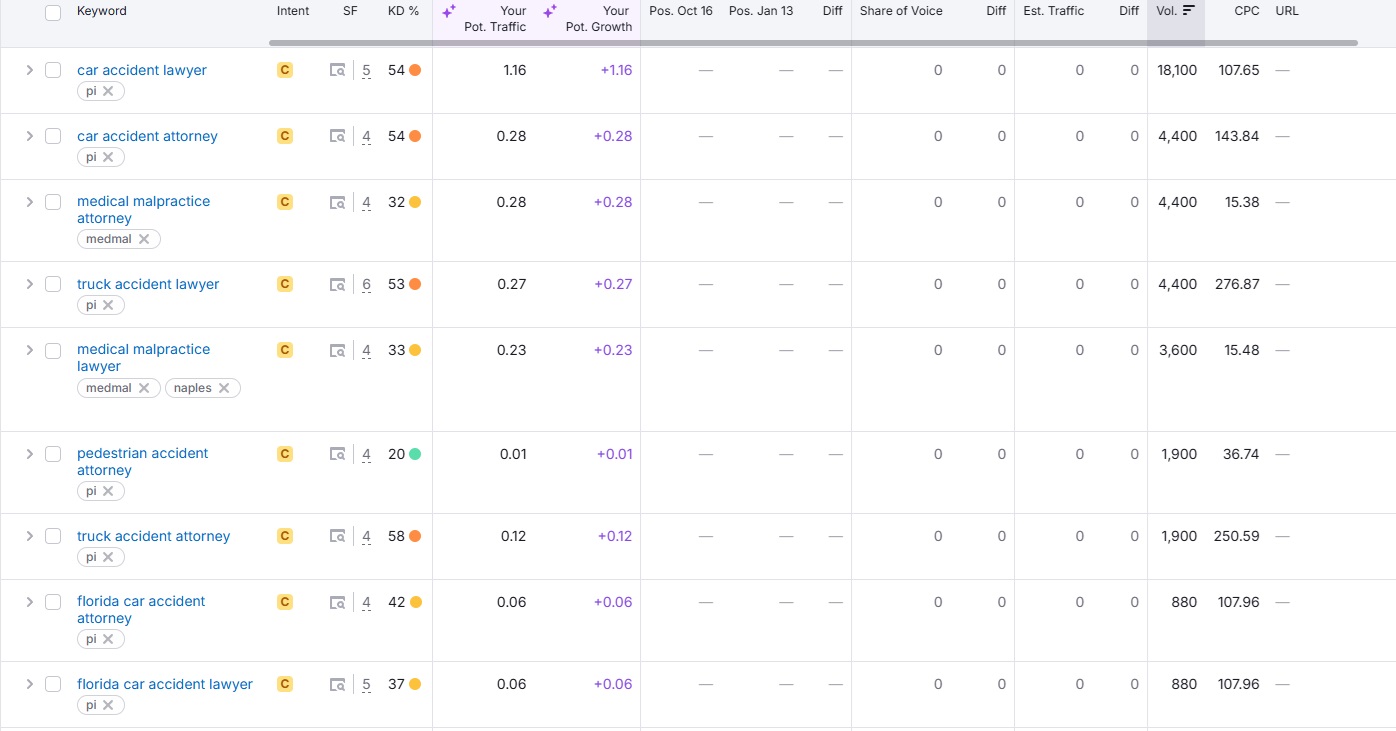
Having the right pages is only the beginning. The next step is to organize them so they make sense for both users and search engines.
Establish a Logical Site Hierarchy and URL Structure
A well-organized site hierarchy and URL structure guides search engines through your content, ensures visitors can easily find what they’re looking for, and makes it simpler for you and anyone managing your site to locate pages as your site grows.
Think of your service areas and markets as silos. Group your service areas and markets into silos to create a logical structure. A logical website structure often follows a hub-and-spoke model: a central pillar page serves as the hub, covering a broad topic, while related sub-pages, or spokes, dive deeper into specific aspects of that topic.
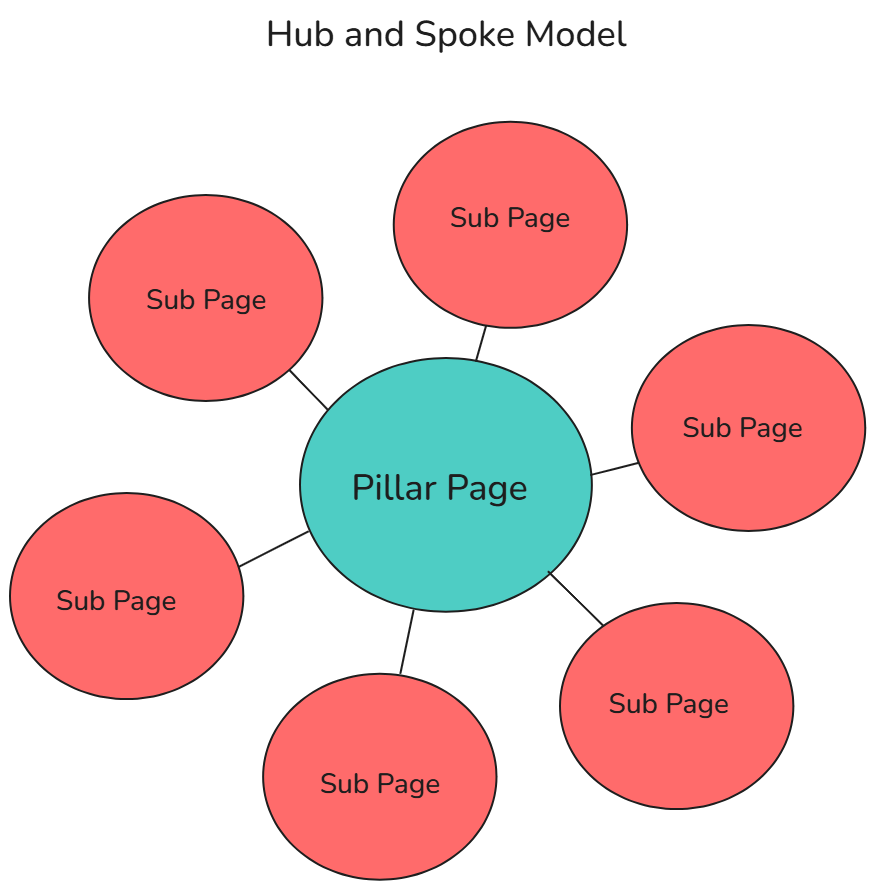
A logical silo structure groups pages by their target location. All pages related to Miami, for example, would fall under the Miami silo, Fort Lauderdale under its own silo, and so on. Within the Miami silo, the Miami personal injury lawyer page could act as the pillar, while sub-pages for car accidents, truck accidents, and other case types serve as spokes.
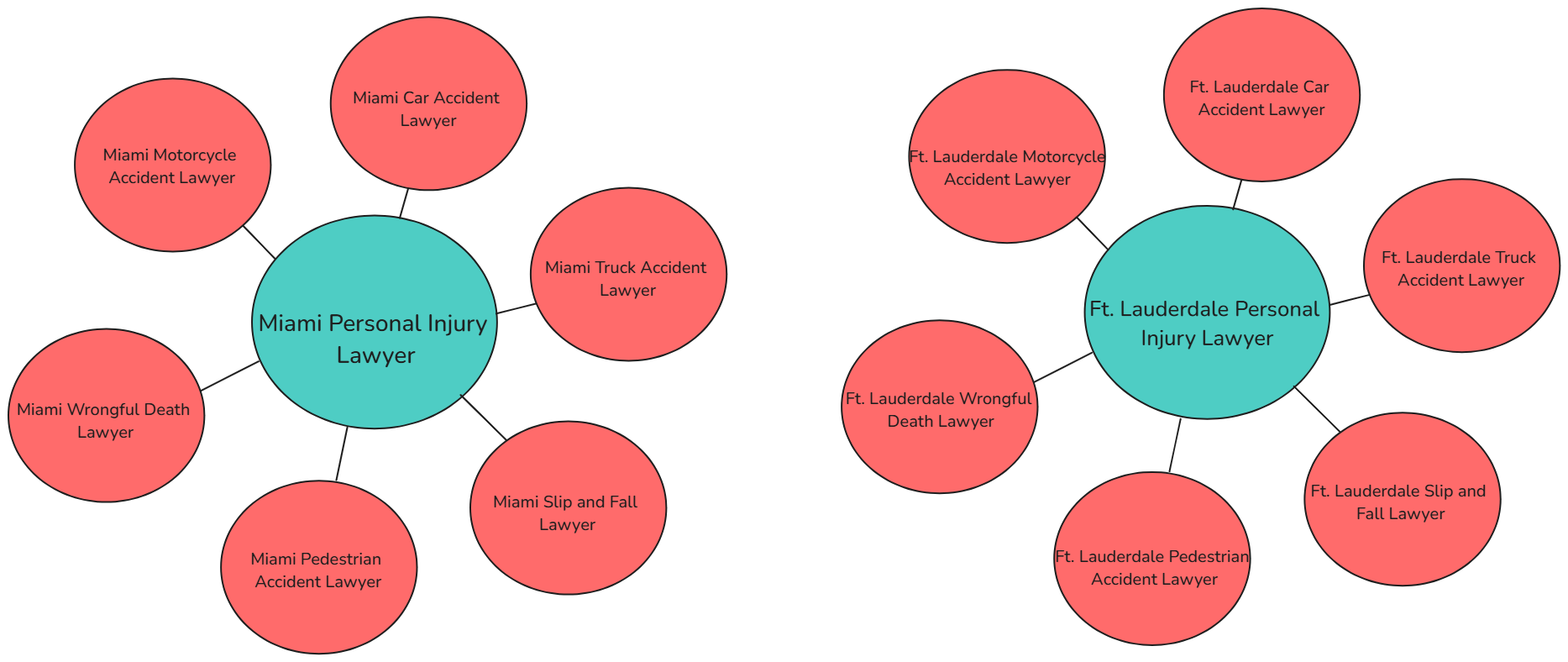
The location silo works well if your firm serves multiple cities or regions and you want to create content specific to each area. For example:

Organize the pages in the silo in a parent-child page hierarchy. Within the silo, the pillar page acts as a parent page with the sub-pages serving as child pages. The parent-child hierarchy creates a logical progression so users and search engines can understand the relationship between your pages.
The examples in the table above illustrate how a parent-child hierarchy can work within a location-based silo. For example, the pillar page example.com/miami-personal-injur-lawyer/car-accident/ positions the Miami personal injury lawyer page as the parent of the Miami car accident lawyer page.
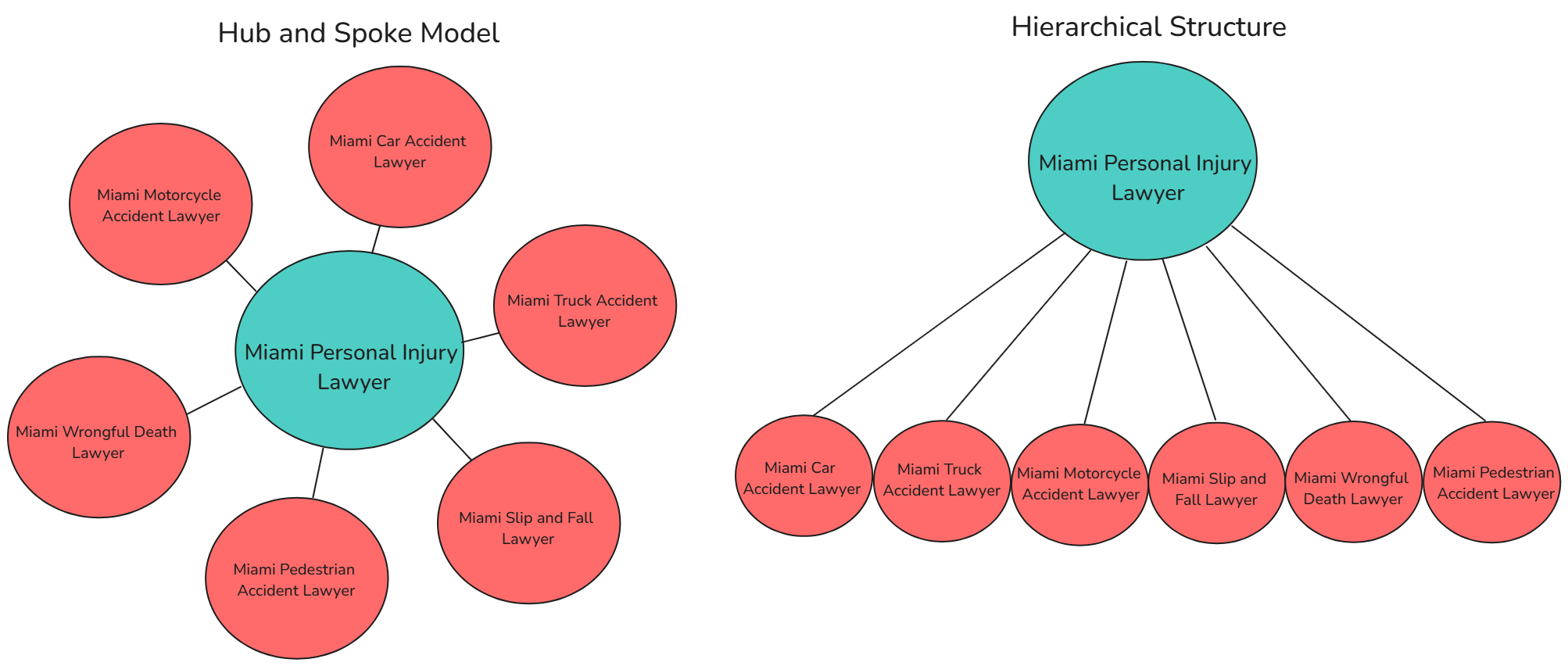
By combining the hub-and-spoke model with a parent-child hierarchy, you build a scalable framework that supports both usability and SEO success.
Build Foreign Language Pages to Reach Non-English-Speaking Clients
If your law firm serves a community with a significant non-English-speaking population, create foreign language pages. These pages expand your reach and build trust with clients who feel more comfortable consuming information in their native language.
Identify the most common languages in your market. For many U.S. law firms, Spanish is often a priority for U.S. law firms, but depending on your region, languages like Mandarin, Vietnamese, or Haitian Creole might be equally important.
Translate key pages on your website. At a minimum, translate your home page, about page, attorney bios, contact page, and the 20 money pages you identified. If resources allow, translate your entire website.
Prioritize accuracy on foreign language pages. If you can, hire a professional translation service with expertise in legal content. At a minimum, use a translation software or AI program to translate the content and have a native speaker review the content for clarity and cultural nuances.
Make foreign language pages easy to find. Consider creating separate subdirectories or subdomains for each language, such as example.com/es/ for Spanish pages. Use hreflang tags to signal to search engines which language and region each page is intended for.
Adding foreign language pages to your website highlights your firm’s commitment to serving the diverse needs of your community. You’ll connect with a wider audience and stand out from competitors who may neglect this important segment of potential clients. Investing in multilingual content positions your firm as an inclusive, trusted resource for legal services in diverse markets.
Next, we’ll focus on the finer details of your website. On-page optimization helps users and search engines better understand your pages and the relationships between them.
On-Page SEO Tactics to Fine-Tune Your Pages for Performance
On-page SEO is all about refining individual pages so they’re user- and search-engine-friendly. Here are two essential tactics to get started:
Streamline Internal Linking
Internal linking creates pathways for users to explore your site and for search engines to understand the relationships between your pages. A strong internal linking strategy ties your content together, making navigation easier for both visitors and search engine crawlers.
Link from parent pages to child pages, and vice versa. Go back to your site hierarchy. The parent-child structure. A pillar page on “personal injury” serves as a parent page and should link to supporting pages like “car accidents,” “truck accidents,” and “slip and fall” as child pages. Likewise, those child pages should link back to the parent page, reinforcing the parent’s authority.
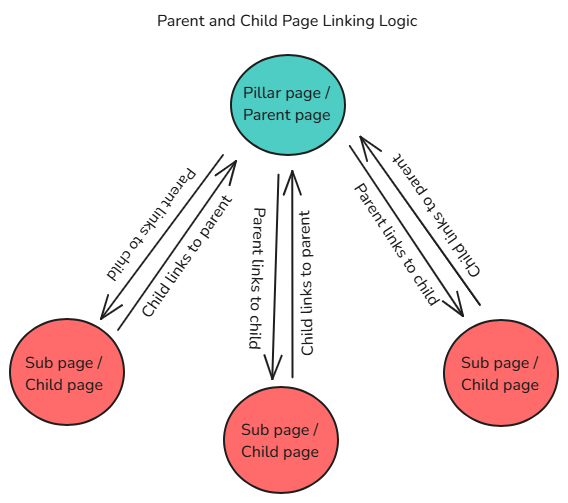
Enhance Metadata
Metadata is one of the simplest yet most powerful tools in your on-page optimization arsenal. Your title tags and meta descriptions are often the first things users see in organic search results, so they need to work hard to grab attention. Well-crafted metadata appeals to users and signals to search engines what your page is about, improving its chances of ranking higher for relevant search queries.
Optimize your title tags with relevant keywords that reflect the page’s intent and keep them concise (50-60 characters). For example:
- Ft. Lauderdale Car Accident Lawyer | Free Consultations
- Miami Slip and Fall Lawyer | Trusted Results Since 2001
- West Palm Beach Truck Accident Attorney | 24/7 Legal Help
Avoid generic titles like “Car Accidents” and instead focus on delivering context and value in just a few words.
Write compelling meta descriptions. Your meta description is, after all, your elevator pitch. It’s your chance to tell users why your page offers exactly what they need. Aim for 140-160 characters summarizing your page’s content while using persuasive, action-oriented language.
For example, instead of a generic “Learn about our personal injury services,” try something more engaging. Here are some examples:
- Discover how our West Palm Beach personal injury lawyers help clients win big in their accident claims. Get a free case evaluation today.
- Trust your car accident claim to our injury lawyers and fight for the money you deserve. Injured drivers in Miami get a free case review.
- Slip and fall injuries can disrupt your life. Our Ft. Lauderdale lawyers fight for compensation while you recover. Free consultations
A strong meta description boosts click-through rates (CTR) by reassuring users that your page meets their needs. If your description doesn’t resonate, Google might rewrite it, pulling snippets from your page. By crafting compelling descriptions, you ensure users see your page as the solution they’re seeking.
With enhanced metadata and a streamlined internal linking structure, your pages will perform better in search results and provide a more intuitive user experience. These small but impactful SEO tactics are essential building blocks for a strong foundation.
Linkbuilding Tactics to Build Your Website’s Authority
Quality linkbuilding is a long game, but the payoff is worth the effort. The goal is to earn backlinks from reputable websites to signal to Google that your site is a trusted and authoritative source. Think of linkbuilding as a gradual process: each backlink is a vote of confidence in your law firm’s expertise. With consistent effort, these links compound, strengthening your website’s authority and facilitating your climb up the search engine rankings.
A proper linkbuilding budget can accelerate the process, but here’s how to start building your site’s link profile.
Start with Business & Legal Directories
Add your firm to reputable business and legal directories. These platforms not only provide backlinks but also improve online visibility for potential clients searching for legal services in your area. Here are a few to consider:
Directories for Law Firms:
- Justia
- FindLaw
- SuperLawyers
- Nolo
- Yelp
- Avvo
- Better Business Bureau
- Yellow Pages
Before we move on, a caveat: Most directory links are nofollow, meaning they don’t pass what some SEOs might call “link juice” or authority to your site. However, some SEOs feel nofollow links offer benefits, as Google may consider them “hints” and may even crawl nofollow links. In any case, adding your firm to directories ranking for relevant keywords like “personal injury lawyer” or “criminal defense lawyer” give prospective clients another way to discover your law firm.
Make sure your business information is accurate and consistent across all directories, including your name, address, and phone number (NAP). Consistency signals that your firm is reliable and trustworthy. It improves your local SEO performance and helps clients find you without confusion.
Leverage Local Media Opportunities
Local media can be a powerful ally in your linkbuilding strategy. By sharing your law firm’s community involvement through local outlets, you earn relevant backlinks while connecting with your local audience.
If your firm sponsors an event, let local news outlets know. Examples include a charity fundraiser or community initiative. Highlight the event’s purpose, how the event helps the community, and your firm’s role. Coverage from reputable local sources adds authority to your site and showcases your firm’s commitment to giving back.
Volunteering efforts are another excellent way to engage the media. Whether your team is participating in a neighborhood cleanup or offering pro bono legal services, volunteering activities resonate with local audiences and often attract media attention. Craft a press release detailing your efforts to increase the chances of being featured on local news sites.
Share information about the resources your firm provides. Offering free legal clinics or educational workshops is not only a valuable service but also a great story for local media. Highlight how your firm is making legal assistance accessible and why this matters to your community. This positions your firm as a trusted resource while earning meaningful backlinks that boost your SEO efforts.
By leveraging local media opportunities, you not only earn valuable backlinks but also strengthen your presence in the community. Now, let’s turn our attention to local SEO tactics that can help your firm stand out in the highly competitive local map results.
Local SEO Tactics to Elevate Your Local Ranking
Local SEO is essential for connecting with clients in your community. Appearing among the top businesses in the map pack makes your law firm more visible and positions you as a leading choice for legal services. It’s the difference between standing out as a trusted local option and getting lost in the search results. Don’t overlook this opportunity to reinforce your status in the community.
Optimize Your Google Business Profile
Your Google Business Profile (GBP) is often the first impression potential clients get of your firm, so make it count. Your GBP allows users to quickly verify key details like your location, business hours, and services before deciding to contact you. A well-optimized GBP boosts your visibility in the map pack and assures potential clients that your firm is established, professional, and ready to help.
Create and maintain a GBP for each of your office locations. If your firm operates from multiple locations, each office needs its own GBP. Relying on a GBP only for your “main” office or headquarters limits your visibility in areas served by other offices. Google prioritizes local relevance in its map pack, meaning potential clients searching near one of your other offices are unlikely to see your law firm in their map results if there’s no dedicated GBP for that location.
Each GBP acts as a digital footprint in its community, improving your visibility where clients are searching for legal help. WBy setting up profiles for all your locations, you not only expand your reach but also reinforce your reputation as a trusted, local option in every market you serve.
Ensure your Name, Address, and Phone (NAP) details are accurate for each profile. Include your business hours, a concise description of your services, and any relevant service categories.
Inconsistent or outdated information confuses potential clients and can cost you business. Perhaps even worse, it signals to Google that your business details may not be reliable, which can hurt your visibility in search results.
Regularly update your GBPs to keep them fresh and relevant. Share announcements about holiday closures or highlights from community events. Active and up-to-date profiles demonstrate that your firm is engaged and ready to help.
Add (and regularly update) photos of your office. High-quality, visually appealing images build trust and make your law firm more relatable to potential clients. Blurry, poorly lit, or unprofessional images can undermine your credibility. Take time to capture clear, well-composed shots that represent your office and team in the best light.
If you don’t have professional equipment, a smartphone with a good camera can do the job. For an even more polished look, consider hiring a local Google-certified photographer who specializes in business profiles. These professionals take photographs that showcase your office and team to make a strong first impression on prospective clients.
Link each GBP to the most relevant page on your website. For example, a GBP for your Miami office should link directly to the most important Miami-specific page on your site. If you’re a personal injury law firm, that’s likely your Miami personal injury lawyer page, not your home page, unless your home page is specifically optimized for “Miami personal injury lawyer.”
A targeted approach improves the user experience and strengthens the SEO signals between your GBP and the corresponding page, helping both rank higher in local search results.
Encourage and Respond to Reviews
Client reviews are a cornerstone of building trust and improving your local SEO rankings. Positive reviews reassure potential clients that others have had a great experience with your firm, while a steady flow of new reviews signals to Google that your business is active, relevant, and worth ranking in the local search results.
Encourage satisfied clients to leave reviews on your GBP. Make it easy by providing a direct link to the appropriate GBP in follow-up emails or thank-you messages. Many clients are happy to share their experiences when asked, especially when they feel they’ve received exceptional service. Consistency is key. Each new review strengthens your profile and boosts your credibility.
To streamline the process, create a simple email sequence to request reviews:
- Email 1: Send a thank you message shortly after the client’s case is resolved. Express gratitude for their trust in your firm. Politely ask for a review and provide a direct link to the appropriate GBP.
- Email 2: A week later, send a friendly follow-up email if they haven’t responded. Emphasize how much their feedback helps others in the community find quality legal help. Include a link to the appropriate GBP.
- Email 3: After another week or two, send a brief and appreciative final message. Reinforce that their input is valuable but avoid applying pressure. Again, include a link to the appropriate GBP.
By keeping the process simple and accessible, you’re more likely to receive positive reviews that enhance your local SEO and build trust with prospective clients.
Respond to all reviews, whether glowing or critical. Responding to positive reviews with gratitude shows you value the feedback and care about your clients. When addressing negative reviews, stay professional and constructive. Acknowledge concerns, offer to resolve issues, and demonstrate your commitment to quality service. A well-handled response can even turn a dissatisfied client into a loyal advocate.
Have a fake review? Don’t panic. We can help with reputation management services designed to address this issue. We’ll work to get the fake review removed, and you only pay if we’re successful.
An actively managed GBP with up-to-date information and thoughtful responses to client reviews shows that your firm isn’t just a faceless business. It’s proof that there’s a real, engaged team behind the online presence. This personal touch builds trust and helps potential clients feel more connected to your law firm even before they reach out.
Next, let’s explore how social media can take that connection even further, helping your firm grow its brand and engage meaningfully with the community.
Social Media Tactics to Grow Your Brand & Engage the Community
If your firm has the resources to hire a dedicated social media manager or the partners are eager to take an active role in creating content, that’s fantastic. Law firms that invest in social media often reap the rewards of a broad and engaging social media presence.
However, you don’t need a massive budget or elaborate content strategy to make social media work for your firm. Focus on the essentials: establish a presence, keep your profiles current, and post regularly. A consistent, well-maintained social media presence strengthens your brand and helps potential clients feel connected to your firm. Whether they find you directly on social platforms or look you up after seeing your firm elsewhere, a strong social presence builds trust and fosters engagement.
Create Profiles on the Major Platforms
Creating and maintaining active profiles on the major platforms is a great start. Each platform offers unique opportunities to connect with potential clients, showcase your expertise, and build your brand:
- X (formerly Twitter)
- TikTok
Maintaining profiles on these platforms provides your firm visibility on the networks where potential and current clients spend their time. These networks have the widest reach and highest user engagement, making it easier for people to discover and connect with your firm on their preferred social media channels.
Post Regularly to Your Social Media Accounts
You don’t need to post every day, but aim for at least once a week to keep your profiles active and engaging. Consistency builds trust and familiarity. Not sure where to start? Here are some ideas:
- Share Firm News: Highlight your law firm’s achievements and involvement in the community. Post news articles that reference your firm, announce volunteer efforts, or promote events you sponsor or host. For example, if you’re organizing a free legal clinic, post details beforehand to encourage attendance and share photos afterward to showcase its impact.
- Celebrate Big Wins: Post about major settlements or verdicts (within ethical and client confidentiality guidelines). Mention the type of case, the settlement or verdict amount (if permissible), and any details that highlight your expertise and success.
- Spread Well Wishes: Celebrate milestones and holidays to humanize your brand. Post holiday greetings, acknowledge staff birthdays, and offer glimpses into your firm’s culture with behind-the-scenes moments.
- Engage with Relevant Legal Topics: If you’re comfortable, have your attorneys comment on legal news, trending topics, or local events. Your firm’s perspective could spark conversations and demonstrate your expertise while showing that your firm is engaged with the broader community.
These posts don’t require a big budget or elaborate planning. They simply require consistency and authenticity. By keeping your content relevant and approachable, you’ll build trust, foster familiarity, and strengthen your connection with your audience over time.
Keep Information on Your Social Profiles Current
Keeping your social media profiles accurate and up to date allows clients to easily find and connect with you. Outdated or inconsistent details confuse users, create a poor first impression, and hurt your credibility. Check these key elements at least once a month to make sure everything is accurate:
- Name, Address, and Phone Number (NAP): Verify your firm’s name, office locations, and phone numbers are correct and consistent across all platforms. Update immediately if there are changes to avoid confusing clients.
- Website Links: Confirm that links to your website are functional and direct users to the correct pages, like your homepage or location-specific pages. Broken or incorrect links can frustrate users and cost you leads.
- Operating Hours: Keep your business hours up to date, especially if they change for holidays or special events. Clients rely on this information to know when and how to reach you.
- Social Links on Website Footer: Link to all your social media profiles in your website’s footer. Test the links regularly to confirm they work and point to the correct profiles.
Reviewing these details monthly helps maintain a professional online presence and reinforces trust with current and potential clients. Accurate and consistent information also reinforces your connection between your social platforms and website, improving your overall visibility and client experience.
Social media doesn’t have to be overwhelming or overly ambitious. With a consistent presence, accurate information, and engaging updates, your law firm can use these platforms to build your brand and connect with clients in meaningful ways.
These SEO Tactics Lay the Groundwork for Growth
The law firm SEO strategies outlined here are small, actionable steps designed to lay a strong foundation for your firm’s growth. These tactics alone won’t dominate competitive markets, but they’re critical first steps toward building meaningful, measurable progress.
While these tactics are manageable if you have the time to focus on them, we know that lawyers and marketing managers often juggle dozens—or even hundreds—of responsibilities.
If you’re short on time or simply want expert support, give us a call. We specialize in SEO for law firms, and we’ll implement these foundational tactics and develop a robust, long-term strategy tailored to your firm’s goals, market, and unique challenges. Whether you’re building a new site, optimizing an existing one, or starting from scratch, we’ll create a plan that sets you on the path to measurable success.
We’re even happy to provide a free website audit.

Alex Valencia is an influential entrepreneur, marketer, speaker, podcaster, and CEO of We Do Web Content, one of Inc. 5000’s fastest-growing businesses in America. His agency implements game-changing content marketing strategies and produces top-ranking web content for law firms, medical professionals, and small businesses nationwide.

